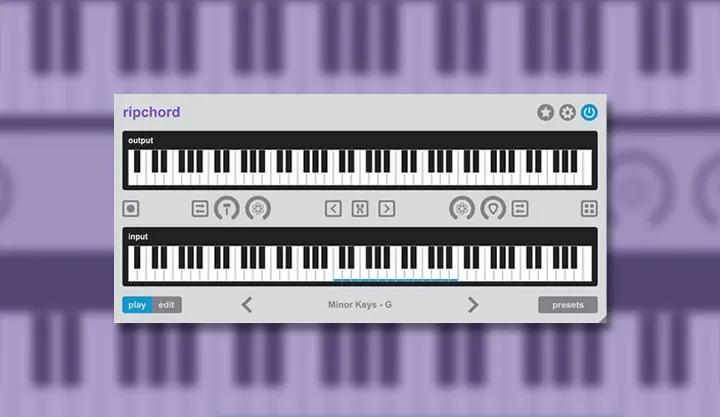Ripchord is a free MIDI plugin for creating and remixing chord progressions. You can create custom chord presets from scratch, load expansion packs, or import any MIDI file that contains chords and Ripchord will automatically create a preset from it. Ripchord helps you easily compose progressions by playing single notes to trigger full chords. You can watch the tutorial on YouTube: Ripchord Overview
Expansion Packs
Anyone is welcome to make expansion packs for Ripchord, and give them away or sell them, without any further permission required. We don't sell any expansion packs directly, or take any kind of cut from third party expansion pack sales.
Open Source
Ripchord is open source under GNU GPLv3. You can check out the source code on Github: Source Code
Plugin Formats
Ripchord is avalailable as an AU or VST3 for Mac, and a VST3 for Windows. We get a lot of requests for a VST2 version of Ripchord. Actually the first version of Ripchord we made was a VST2, and then we found out that Steinberg would not let us give it to anyone. Steinberg stopped granting any new VST2 licenses in 2018 because they are trying to retire the format, so unfortunately that is the end of the story. This also means that whatever DAW you use must support the full VST3 MIDI spec in order to use Ripchord. More details can be found here: VST2 is Discontinued
Play Mode
Ripchord has two modes, play and edit. Most of the time you will be in play mode, in which you can either play an external MIDI keyboard, or click on the input keys with a mouse, in order to trigger the chords in your preset and compose progressions.
1.
(Button) Favorites or unfavorites the currently loaded preset.
2.
(Button) Opens the menu.
3.
(Button) Allows the chords to be enabled or disabled while maintaining the MIDI routing.
4.
(Button) Contains any MIDI that has been recorded. When it is fully illuminated you can click and drag the MIDI from this button into your DAW.
5.
(Button) Switches between the presets view and the keyboards view.
6.
(Display) The name of the currently loaded preset will be displayed here.
7.
(Arrows) Select the next or previous presets in your collection. You can also use the left, right, up, and down keys on your computer's keyboard to trigger these buttons.
8.
(Button) Switches between play and edit mode.
9.
(Button) Clicking once enables MIDI recording. When enabled, recording will begin the moment the first input note is recieved. Clicking this button a second time will disable MIDI recording.
10.
(Button) Switches the direction of the velocity strum between always LTR, always RTL, LTR then alternate, or RTL then alternate. It can only be clicked if the velocity strum knob has been engaged.
11.
(Knob) Increases the velocity strum, which is the difference in velocity between the first and last notes of a chord. The difference will be spread evenly across all of the notes.
12.
(Knob) Increases the velocity humanization, which is random variation in velocity between all of the notes in the chord.
13.
(Button) Moves the transpose keys to the left on the input keyboard. It can only be clicked if the transpose button has been engaged.
14.
(Button) Engages the transpose keys. When engaged, the bottom two octaves of the input keyboard will operate in latch mode to transpose the chords in the preset up or down one full octave.
15.
(Button) Moves the transpose keys to the right on the input keyboard. It can only be clicked if the transpose button has been engaged.
16.
(Knob) Increases the note humanization, which is random variation in timing between all of the notes in the chord.
17.
(Knob) Increases the note strum, which is the difference in timing between the first and last notes of a chord. The difference will be spread evenly across all of the notes.
18.
(Button) Switches the direction of the note strum between always LTR, always RTL, LTR then alternate, or RTL then alternate. It can only be clicked if the note strum knob has been engaged.
Edit Mode
Edit mode can be used to create a new preset from scratch, or to edit an existing preset. In edit mode, when you mouse click on the input keys, instead of triggering the chord, it will select the input key so that you can assign or modify the output keys that are mapped to it. You can still trigger the chords in edit mode if you have an external MIDI keyboard hooked up, that way you can preview the chords as you edit them.



